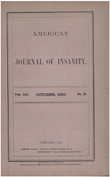The Melbourne Family Grief Study, I: Perceptions of family functioning in bereavement
Abstract
OBJECTIVE: The aim of this study was to identify patterns of family functioning in adult families after the death of a parent. METHOD: One hundred fifteen families completed measures of family functioning, grief, psychological state, and social adjustment 6 weeks (time 1), 6 months (time 2), and 13 months (time 3) after the death of a parent (a total of 670 individual responses). Cluster analytic methods were applied to develop a typology of perceptions of family functioning during bereavement. RESULTS: Five types of families emerged from dimensions of cohesiveness, conflict, and expressiveness on the Family Environment Scale. Thirty-six percent of the families were considered supportive because of their high cohesiveness, and another 23% resolved conflict effectively. Two types were dysfunctional: hostile families, distinguished by high conflict, low cohesiveness, and poor expressiveness, and sullen families, who had more moderate limitations in these three areas; they declined in frequency from 30% at time 1 to 15% at time 3. The remaining type (26%), termed intermediate, exhibited midrange cohesiveness, low control, and low achievement orientation. The typology at time 1 predicted typologies at time 2 and time 3. There were no age or gender differences among the family types, but offspring, as compared with spouses, were overrepresented in the hostile families. CONCLUSIONS: Family types can be identified, allowing at-risk families to be helped to prevent complications of grief. Screening with the family relationship index of the Family Environment Scale would facilitate such a family-centered approach.
Access content
To read the fulltext, please use one of the options below to sign in or purchase access.- Personal login
- Institutional Login
- Sign in via OpenAthens
- Register for access
-
Please login/register if you wish to pair your device and check access availability.
Not a subscriber?
PsychiatryOnline subscription options offer access to the DSM-5 library, books, journals, CME, and patient resources. This all-in-one virtual library provides psychiatrists and mental health professionals with key resources for diagnosis, treatment, research, and professional development.
Need more help? PsychiatryOnline Customer Service may be reached by emailing [email protected] or by calling 800-368-5777 (in the U.S.) or 703-907-7322 (outside the U.S.).



